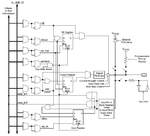mjuneja
Advanced Member level 4
- Joined
- Aug 28, 2016
- Messages
- 105
- Helped
- 12
- Reputation
- 24
- Reaction score
- 10
- Trophy points
- 18
- Location
- Bangalore, India
- Activity points
- 674
Hello guys
I want to understand how user I/Os pins in FPGA, which can be programmed either as input, output or bidirectional pin in VHDL/Verilog source code; are realized inside FPGA to function either as input or output or bidirectional pin.
Do we have tristate buffer to implement such functions or something else ?
Does it depend on the technology as well ?
I want to understand how user I/Os pins in FPGA, which can be programmed either as input, output or bidirectional pin in VHDL/Verilog source code; are realized inside FPGA to function either as input or output or bidirectional pin.
Do we have tristate buffer to implement such functions or something else ?
Does it depend on the technology as well ?
